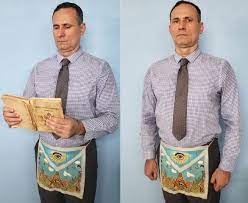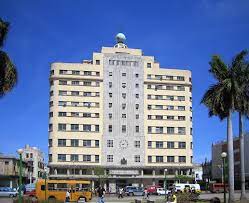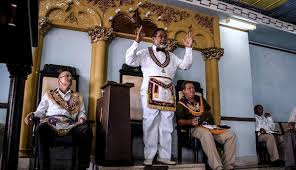FREEMASONRY IN CUBA AND ITS INFLUENCE ON THE SOCIAL POLITICS ON THE ISLAND
The word “masonry” comes from the French “mason”, which means “bricklayer.” Indeed, in the beginning, Freemasonry was a kind of brotherhood or brotherhood of masons specialized in carrying out large constructions, such as cathedrals and the palaces of kings and princes. That is why they used the square and the compass in their initiation rites, and their degrees were in accordance with the same masonry trade: apprentice, companion, teacher, etc.
The Catholic Church prohibits belonging to Freemasonry because it is a secret society, it rejects all supernatural religion: Revelation, the Bible, the dogmas of faith, the mysteries, etc. and it is essentially concerned with the interests of its members, but at the same time acts on the basis of dogmatic principles. To be a Mason you have to believe in some god (of Christianity, Jew, etc.) no matter which one. That is why he is named GADU (Great Architect of the Universe) so that there are no religious discriminations. (In Freemasonry, neither religious nor political subjects are discussed).
The rich Masonic history of Cuba is very extensive. Freemasonry is not a political organization, although its members were sometimes persecuted for political reasons. Nor is it a religious sect, although its adherents confess an absolute faith towards its principles. In the past the Catholic Church treated them as heretics and many monarchies considered them a fatal threat to their crowns for their insistent vocation to oppose any religious or political tyranny. But, undoubtedly, Freemasonry has already left behind its most glorious moments, when the names of great literati, musicians, and thinkers prestigious its ranks. Far away has been that golden age when Mozart wrote his Masonic cantata “The Praise of Friendship”, inspired by the ideals of brotherhood, or the French revolutionaries of 1789 shouted through the streets of Paris the Mason motto of Liberté, Egalité, Fraternité. But from George Washington to Benito Juárez (without forgetting Walt Disney) the social influence that this fraternal association has had in modern history is undeniable.
NATIONAL MASONIC TEMPLE IN CHARLES III AND BELASCOAIN.
In Cuba, Freemasonry also has an illustrious past, inextricably linked to the formation of nationality itself, and in its ranks were the men who later fought for the country’s independence. Antonio Maceo, belonged to him since 1864, Ignacio Agramonte and other illustrious people from Camagüey began in the lodge “Tínima No. 16”, and in Bayamo “La Estrella Tropical No. 19” grouped among others Perucho Figueredo, Francisco Vicente Aguilera and Carlos Manuel de Céspedes, the Father of the Nation. And of course, documents found in a lodge in the city of Cienfuegos, confirm the Masonic affiliation of José Martí, who had the influence of his closest teachers such as José María de Mendive and was already a member of that organization at age 18.
The Cuban Freemasons became very strong and inaugurated the Grand Lodge based in Havana. But with the revolutionary triumph, Freemasonry begins to face difficulties: their financial resources significantly decreased and many of their private philanthropic efforts were limited, due to the profound changes that occurred in the country. To this is added the exodus abroad of a part of its members, while very few young people were interested in entering the institution and preferred to dedicate themselves entirely to a process that promised to fully comply with everything that the Masons have always raised as to its greatest motto: “Liberty, Equality, Fraternity”. From 34,000 members in 1959, the number had dropped to 19,582 in 1981.
Starting in 1982, a slight growth has been observed that will not stop until the present, when its membership amounts to more than 28 thousand affiliates.
INCREASE IN CITIZEN PARTICIPATION
Since the beginning of the Cuban revolutionary process in 1959, hundreds of freemasons were confined in Cuban prisons for their opposition to the Castro dictatorship and some were fire squad, thus beginning a process that has developed during years of permanence of the communist autocracy in Cuba. . In the prisons of Cuba Masonic and Jefist Lodges were founded as the so-called Lodge of “Light in the Darkness” in the prisons of Isla de Pinos (today Isla de la Juventud).
In 1992 a group of Cuban Freemasons was arrested for belonging to the Cuban Revolutionary Party for Human Rights (PRCPDH). For six months, they were investigated and interrogated by the SEC. The PRCPDH met both in the lodges and in the houses of its members, who proposed to develop proclamations, posters, and other actions, with the aim of raising awareness about the damage that the regime was doing to Cuba and its consequences.
Another of the most scandalous cases of political pressure in Cuba occurred in 2003 when seventy-five dissidents were jailed, including at least twelve Freemasons. One of them was José Daniel Ferrer García, who years later founded the Patriotic Union of Cuba (UNPACU).
Cuban nationality is founded on the blood and sacrifice of the Masons. The history of Cuba is forged in the character of those Freemasons who, since they began to think about a homeland and dreamed of a country, have been shaping who we are until today, bequeathing us a patriotic culture, an intangible part of the Cuban idiosyncrasy. Although in the last sixty years they have tried to erase or distort that trace, they have not been able to do so. On the other hand, more than sixty years of darkness do not stain that work.
Today in Cuba there are about 28,000 Masons subdivided into 320 lodges throughout the Island.
The Masonic order, as the main promoter of freedoms, has been – and is – a fundamental actor in Cuban society; therefore, it is not an isolated entity, but constitutes a selection of men who study social and human problems and take sides with reason and justice; having Liberty and the well-being of the peoples as currency; so it has to, inevitably, get involved in the different social controversies as a way in addition to putting into practice the ideals it promotes.
LA MASONERIA EN CUBA Y SU INFLUENCIA EN LAS POLÍTICAS SOCIALES DE LA ISLA
La palabra «masonería» viene del francés «masón «, que quiere decir «albañil». En efecto, al principio la masonería era una especie de cofradía o hermandad de albañiles especializados en realizar las grandes construcciones, como las catedrales y los palacios de los reyes y los príncipes. Por eso usaban en sus ritos de iniciación la escuadra y el compás, y sus grados estaban de acuerdo con el mismo oficio de la albañilería: aprendiz, compañero, maestro, etc.
La Iglesia Católica prohíbe pertenecer a la masonería porque se trata de una sociedad secreta, rechaza toda religión sobrenatural: la Revelación, la Biblia, los dogmas de fe, los misterios, etc. y se preocupa esencialmente por los intereses de sus miembros, pero a su vez actúa sobre la base de principios dogmáticos. Para ser masón tienes que creer en algún dios (del cristianismo, judío, etc.) no importa cual. Por eso se lo nombra como GADU (Gran Arquitecto del Universo) para que no haya discriminaciones religiosas. (En la masonería no se discuten ni temas religiosos ni temas políticos).
La rica historia masónica de Cuba es bien extensa. La masonería no es una organización política, aunque en ocasiones sus miembros fueron perseguidos por causas políticas. Tampoco es una secta religiosa, aunque sus adeptos confiesan una fe absoluta hacia sus principios. En el pasado la Iglesia Católica los trató como a herejes y muchas monarquías los consideraban una amenaza fatal para sus coronas por su insistente vocación de oponerse a cualquier tiranía religiosa o política. Pero, indudablemente, la masonería ya ha dejado atrás sus momentos más gloriosos, cuando los nombres de grandes literatos, músicos, y pensadores prestigiaban sus filas. Muy lejos ha quedado aquella época dorada en que Mozart escribía su cantata masónica “El elogio a la amistad”, inspirado en los ideales de la hermandad, o los revolucionarios del 1789 franceses gritaban por las calles de París el lema masón de Liberté, Egalité, Fraternité. Pero desde George Washington a Benito Juárez (sin olvidar a Walt Disney) es innegable la influencia social que ha tenido esta asociación fraternal en la historia moderna.
TEMPLO NACIONAL MASONICO EN CARLOS III Y BELASCOAIN.
En Cuba la masonería también cuenta con un pasado ilustre, indisolublemente ligado a la formación misma de la nacionalidad y en sus filas militaron los hombres que luego lucharon por la independencia del país. Antonio Maceo, pertenecía a él desde 1864, Ignacio Agramonte y otros ilustres camagüeyanos se iniciaron en la logia “Tínima No. 16”, y en Bayamo “La Estrella Tropical No. 19” agrupaba entre otros a Perucho Figueredo, Francisco Vicente Aguilera y Carlos Manuel de Céspedes, el Padre de la Patria. Y por supuesto, documentos hallados en una logia de la ciudad de Cienfuegos, confirman la afiliación masónica de José Martí, quien tuvo esa influencia de sus más cercanos maestros como José María de Mendive y ya militaba en esa organización a los 18 años.
Los masones cubanos llegan a tener gran fuerza e inauguran la Gran Logia con sede en La Habana. Pero con el triunfo revolucionario la Masonería comienza a enfrentar dificultades: disminuyeron sensiblemente sus recursos financieros y vieron limitadas muchas de sus gestiones filantrópicas de carácter privado, debido a los profundos cambios ocurridos en el país. A esto se suma el éxodo hacia el exterior de una parte de sus miembros, mientras que muy pocos jóvenes se interesaban por ingresar en la institución y preferían dedicarse por entero a un proceso que prometía cumplir con creces todo aquello que los masones han enarbolado siempre como su mayor divisa: “Libertad, Igualdad, Fraternidad”. De 34 mil miembros en 1959, la cifra se había reducido a 19.582 en 1981.
A partir de 1982 se advierte un ligero crecimiento que ya no se detendrá hasta el presente, cuando su membresía asciende a más de 28 mil afiliados.
AUMENTO EN LA PARTICIPACIÓN CIUDADANA
Desde el comienzo del proceso revolucionario en Cuba en 1959, cientos de masones fueron confinados en las carceles de Cuba por su oposicion a la dictadura castrista y algunos fusilados, comenzando asi un proceso que se ha desarrollado durante años de permanencia de la autocracia comunista en Cuba. En las carceles de Cuba se fundaron Logias Masonicas y Ajefistas como la llamada Logia de “Luz en las Tinieblas” en las carceles de Isla de Pinos (hoy Isla de la Juventud).
En 1992 un grupo de masones cubanos resultaron detenidos por pertenecer al Partido Revolucionario Cubano Pro Derechos Humanos (PRCPDH). Durante seis meses, fueron investigados e interrogados por la SEC. El PRCPDH se reunía tanto en las logias como en las casas de sus miembros, los cuales se proponían desarrollar proclamas, carteles y otras acciones, con el objetivo de concientizar sobre el daño que el régimen hacía a Cuba y sus consecuencias.
Otro de los casos más escandalosos en cuanto a presiones políticas en Cuba ocurrió en el año 2003 cuando setenta y cinco disidentes fueron encarcelados, entre ellos se hallaban al menos doce masones. Uno de ellos era José Daniel Ferrer García, quien años más tarde fundaría la Unión Patriótica de Cuba (UNPACU).
La nacionalidad cubana está cimentada en la sangre y el sacrificio de los masones. La historia de Cuba está forjada en el carácter de esos masones que, desde que comenzaron a pensar en patria y soñaron con un país, fueron moldeando lo que somos hasta hoy, legándonos una cultura patriótica, parte intangible de la idiosincrasia del cubano. Aunque en los últimos sesenta años se ha querido borrar o tergiversar esa huella, no lo han podido lograr. Por otro lado, mas de sesenta años de tinieblas no manchan esa obra.
Hoy en Cuba hay unos 28,000 masones subdivididos en 320 logias en toda la Isla.
La orden masónica, como principal promotora de las libertades, ha sido -y es- un actor fundamental en la sociedad cubana; por ende, no es un ente aislado, sino que constituye una selección de hombres que estudia los problemas sociales y humanos y toma partido al lado de la razón y la justicia; teniendo por divisa la Libertad y el bienestar de los pueblos; por lo que tiene que, inevitablemente, involucrarse en las diferentes polémicas sociales como forma además de llevar a la práctica los ideales que promueve.
Agencies/ Wiki/ MemoriasCubanas/ Carlos RodriguezB./ Cubanet/ Internet Photos/ Arnoldo Varona/ VIDEOS – PHOTOS> LA HISTORIA DE CUBA
THE CUBAN HISTORY, HOLLYWOOD.



 FREEMASONRY in Cuba and its Influence on the Social Politics on the Island. * LA MASONERIA en Cuba y su Influencia en las Políticas Sociales de la Isla. PHOTOS.
FREEMASONRY in Cuba and its Influence on the Social Politics on the Island. * LA MASONERIA en Cuba y su Influencia en las Políticas Sociales de la Isla. PHOTOS.








